
Rentsync National Rental Demand Report: December 2020
Executive Summary
In this comprehensive national rental demand report, we outline significant changes in rental market demand across Canada. The data presented here is the largest data-backed analysis of rental market demand in Canada using aggregate ILS data (over 20 rental listing sites).
The data included in the Rentsync National Rental Demand Report can be used to compare and contrast demand and lead volume for the properties you manage within a given city, and will allow you to make more sound decisions on marketing and advertising.
As you observe demand and lead volume percentage, it's possible to measure this against your own metrics, and see whether you are in line with current industry trends, and if not, how to pivot your strategies as a result.
Methodology
In order to present this data, Rentsync has determined three key calculations for each area of the report, they are as follows:
Demand Score: Our demand score is rated out of 10 (with 10 being the highest score a city can receive), and is calculated based on unique prospects, per property, per city, and compared against benchmark data from the past 12 months.
For example: Oshawa, ON received a demand score of 4.5 this month, versus 6.4 last month. Therefore, Oshawa experienced a decrease in demand (unique prospects per property) by 0.9 points this month.
Unique Prospects Percentage (% +/-): This is determined according to the year-over-year (YOY) or month-over-month (MOM) increase or decrease (aka the demand) in unique prospects per property / per city.
For example: In 2020, the month-over-month unique prospects in Oshawa, ON went down 30% in November versus October. In November 2020, the year-over-year unique prospects in Oshawa, ON went up 10% compared to November 2019.
Position: The position is determined by unique prospects per property, with cities that have at least *20 properties or more. Position will vary depending on demand.
For example: This month, Oshawa moved down 1 spot (from 1st to 2nd on the list) versus last month due to a decrease in unique prospects per property by 30%. Whereas Surrey, BC moved up 1 spot (from 2nd to 1st on the list) versus last month due to an increase in unique prospects per property by 4%.
*The following report provides month-over-month ILS data for November versus October 2020, as well as a year-over-year comparison from November 2020 versus November 2019. It also outlines the month-over-month and year-over-year trends in primary, secondary, and tertiary markets.
Key Takeaways:
Month-over-month (M/M):
Overall, total unique prospects from October to November decreased 12.5%, additionally, an overall increase in supply (+3.4%) from October to November, especially in Primary (+2.5%), Secondary (+8.2%), and Tertiary (2%) markets, has impacted the number of unique prospects per property in the majority of Canadian cities from November versus October.
It is possible to hypothesize that some decrease in demand is due to seasonal declines as well as a consequence of government lockdowns in specific metropolitan areas across Canada due to rising COVID-19 cases.
However, it's important to note that in Oct 2019 vs Nov 2019, we saw an average decline of 7.58 prospects per property, which is comparable to Oct 2020 vs Nov 2020, where we also saw a similar decline of 7.38 prospects per property, thus in line with seasonal downward trends.
Another trend worth noting is that total unique prospects were up 13.6% in November 2020 versus April 2020 of this year (during the initial government lockdowns due to COVID-19). Therefore, it is possible to conclude that multifamily owners, operators and renters, are adapting to lockdowns and finding ways to rent more effectively than they had at the beginning of the pandemic.
Year-over-year (Y/Y): Overall, total unique prospects for multifamily residential housing is actually up 17.2% this year, versus the same time last year, however, supply is also up 33.4% with more than 2,857 new properties entering the long-term rental market this year versus the same time last year.
Therefore, increased supply has impacted unique prospects per property across the majority of Canadian cities. As more supply floods the market (i.e. Airbnbs), demand is being spread out.
There continues to be a consistent downward trend in Primary and some Secondary markets that are more densely populated, and have higher rent rates. We can provide a thesis that this is due to COVID-19's impact on migration away from urban city centers to locations with more space and more affordable housing, as remote work continues to increase.
Top 50 Canadian Cities in Rental Demand: December Report
*Demand is calculated using unique prospects per property per city for Nov 2020 versus Oct 2020

Notable Changes in Demand Over the Past Month
Upwards
Western cities such as Surrey, BC (+0.3), Kamloops, BC (+0.4), and Richmond, BC (+0.2) all experienced an increase in demand this month from the previous month.
Windsor, ON moved up 8 spots, and saw an increase in demand of 0.3, and a 19% increase in unique prospects per property.
Quebec City, QC remained in the same position but saw a 0.2 increase in demand, and a 13% increase in unique prospects per property.
Sherwood Park, AB entered the top 50 list, and saw a 0.1 increase in demand, and an increase of 5% unique prospects per property this month.
Downwards
Waterloo, ON dropped 5 spots this month, reduced demand by 0.6 points, and saw a 31% decrease in unique prospects per property.
Cambridge, ON dropped 11 spots, a reduced demand by 0.9 points, and 31% decrease in unique prospects per property this month.
Brampton, ON dropped 18 spots, reduced demand by 0.9, and decreased unique prospects per property by 52%.
Barrie, ON dropped 7 spots, reduced demand by 1.4 points, and 35% in unique prospects per property this month.
Nepean, ON dropped 9 spots, reduced demand by 0.7 points, and saw a 34% decrease in unique prospects per property.
Burlington, ON dropped 8 spots, reduced demand by 0.4, and experienced a decrease of 26% in unique prospects per property.
Victoria, BC dropped 7 spots this month, decreased demand by 0.4 points, and had a decrease of 22% in unique prospects per property.
East York, ON dropped 8 spots, reduced demand by 1.2, and a reduction of 16% in unique prospects per property this month.
Ottawa, ON dropped 6 spots, reduced demand by 0.2 points, and saw a 24% reduction in unique prospects per property.
Sarnia, ON dropped 6 spots this month, had a reduced demand of 0.2 points, and a decrease of 29% unique prospects per property.
Fort McMurray, AB dropped 6 spots, reduced demand by 0.2 points, and saw a decrease of 23% in unique prospects per property.
Top 10 Canadian Cities in Demand Drill Down (M/M): Nov 2020 vs. Oct 2020

Key Trends for Top 10 Canadian Cities in Demand (M/M)
- Surrey, BC moved up 1 spot and experienced an increased demand by 0.3 points from the previous month, and an increase of 4% in unique prospects per property.
- Oshawa, ON dropped 1 spot and reduced demand by 1.9 points, and experienced a 30% decrease in unique prospects per property.
- Richmond Hill, ON entered the top 10 this month (likely due to an increase in available properties on listing sites), and experienced a decrease in demand by 2.0 points, with a 35% decrease in unique prospects per property.
- Abbotsford, BC moved up 1 spot this month, and saw a decrease in demand of 0.5 points, with a decrease of 17% in unique prospects per property.
- Kitchener, ON moved up 3 spots on the top 10 list this month, however reduced demand by 2.2 points, and a decrease of 22% in unique prospects per property for the month.
- New Westminster, BC moved down 3 spots, experienced a reduced demand of 1.0 point, and a 37% decrease in unique prospects per property for the month.
- Welland, ON moved up 3 spots this month, decreased demand by 0.9 points, and decreased unique prospects per property by 21%.
- Brantford, ON moved down 4 spots, had a decline in demand of 0.9 points, and a 17% decrease in unique prospects for the month.
- Burnaby, BC remained in the same spot on the list, but declined in demand by 0.9 points, and decreased 29% in unique prospects per property.
- Nanaimo, BC moved down 3 spots this month, saw a declined demand of 0.7 points, and decreased unique prospects per property by 32%.
*Richmond Hill, ON increased its number of properties on ILS' to over 20 this month, and is therefore now part of our data set. Last month, it did not have the minimum amount of properties to be included.
Top 10 Canadian Cities Drill Down (Y/Y): Nov 2020 vs. Nov 2019
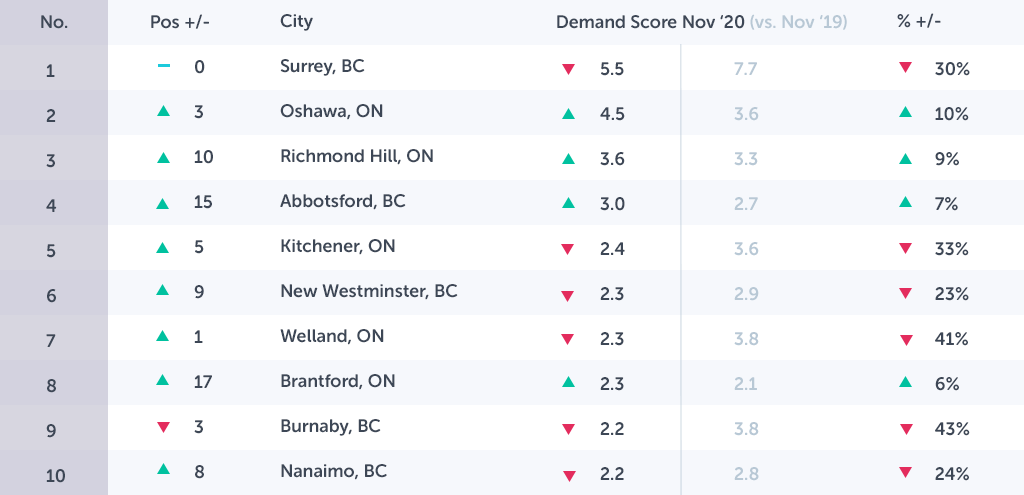
Key Trends for the Top 10 Canadian Cities in Demand (Y/Y)
Surrey, ON remained in the top spot from this time last year, but decreased demand by 2.2 points, and decreased 30% year-over-year in unique prospects per property.
Oshawa, ON moved up 3 spots this year, increased demand by 1.1 points, and experienced an increase of 10% in unique prospects per property this year versus last year.
Richmond Hill, ON moved up 10 spots this year, increased demand by 0.3 points, and saw an increase of 9% in unique prospects per property.
Abbotsford, BC moved up 15 spots this year versus last year, with an increased demand of 0.3 points, and a 7% increase in unique prospects per property.
Kitchener, ON moved up 5 spots on the list, but decreased demand by 1.2 points, and decreased unique prospects per property by 33%.
New Westminster, BC moved up 9 spots, and had a reduced demand of 0.6 points versus this time last year, and saw a reduction of 23% in unique prospects per property.
Welland, ON moved up 1 spot, with a decreased demand of 1.5 points, and a decrease in unique prospects per property by 41%.
Brantford, ON moved up 17 spots, increased demand by 0.2, and increased unique prospects per property by 6% this year versus last year this time.
Burnaby, BC moved down 3 spots on the list, and saw a 1.6 reduction in demand, and a decrease of 43% unique prospects per property.
Nanaimo, BC moved up 8 spots, despite reduced demand of 0.6 points, and a decrease of 24% unique prospects per property versus the same time last year.
*The increase in demand found in Oshawa, Richmond Hill, Brantford, and Abbotsford, could be related to remote work and migration to less densely populated areas with reduced rent rates.
*We have an additional 2,857 new properties listed (+33.4%) on ILS' this year versus last, giving the appearance of a poorer performance in 2020 vs 2019, but we actually see a 17.2% increase in total unique prospects versus the same time last year.
*These trends are consistent with what we have witnessed since the beginning of COVID-19. Cities with denser populations and/or those reporting an increase in cases, are experiencing a reduction in demand and increase in supply, (in part due to short-term rentals entering the long-term rental market), some secondary, tertiary, and those with even smaller populations that provide more living and working space at affordable rates are seeing more stability and/or an increase in demand.
An Analysis of Key Canadian Markets
In order to better segment our data and analyze what is happening within specific markets across Canada, we have broken down our data into 3 key markets:
- Primary (Populations Over 600K)
- Secondary (Populations Between 600-235K)
- Tertiary (Populations Between 235-175K)
Here we will gain a deeper perspective on demand across larger populations, and any movement due to the impact of COVID-19 on the rental market.
Primary Markets (Populations >600K)
Canadian Cities – Primary Market Drill Down: Nov 2020 vs. Oct 2020
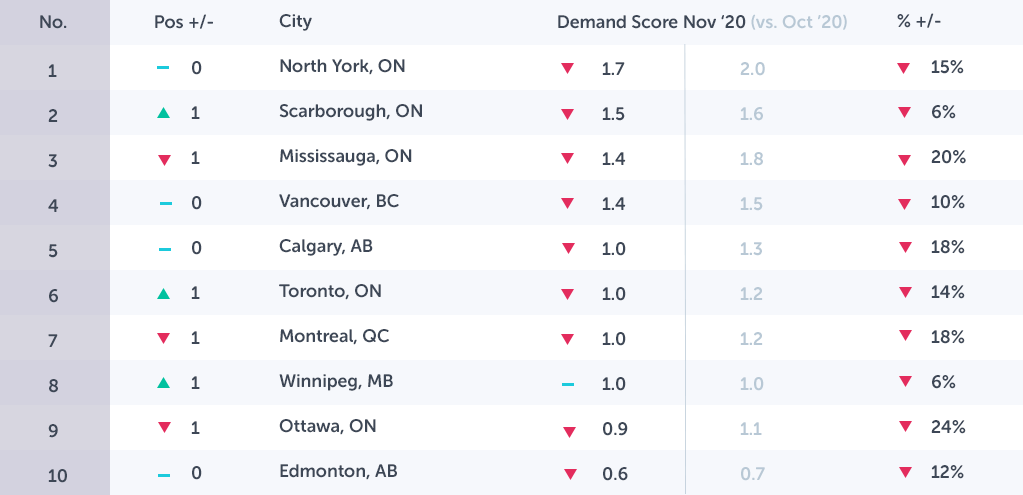
Notable Changes in Primary Markets Over the Past Month
Downward
North York, ON saw a reduction of 0.3 in demand and a decrease of 15% in unique prospects per property this month versus last.
Mississauga, ON had a reduced demand of 0.4 points and a decrease of 20% unique prospects per property this month.
Calgary, AB reduced demand by 0.3 points and experienced an 18% decrease in unique prospects per property this month.
Montreal, QC experienced a decrease of 0.2 demand points and a 18% decrease in unique prospects per property this month.
Ottawa ON experienced a decrease of 0.2 points in demand, and a 24% decrease in unique prospects per property this month.
*Overall demand in primary markets continued to fall month-over-month, as overall supply increased by +2.5% in primary markets this month, and is expected due to seasonal shifts in demand and the impact of COVID-19 shutdowns.
*In primary markets, unique prospects per property* decreased by -14.4% on average this month.
*Additionally, total unique prospects decreased on average -12.1% this month versus last month. (See the year-over-year analysis below, for more perspective on demand in primary markets.)
Canadian Cities – Primary Market Drill Down (Y/Y): Nov 2020 vs. Nov 2019
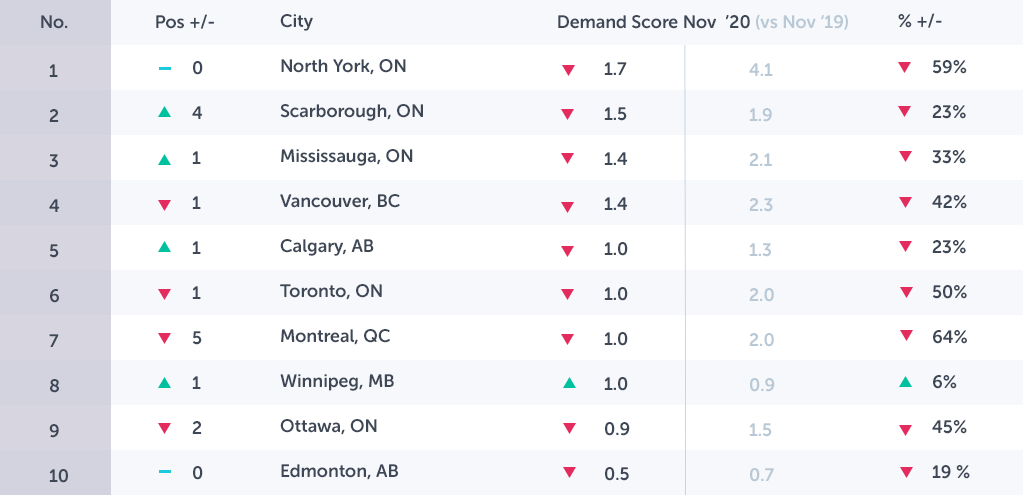
Notable Changes in Primary Market Demand Over the Past Year
Upward
Winnipeg, MB has experienced a slight increase in demand (0.1) from this time last year and has moved up 1 spot in primary markets, and an increase of 6% in unique prospects per property year-over-year.
Downward
North York, ON saw a decrease of 2.4 in demand and a 59% decline in unique prospects per property this year versus last year.
Scarborough, ON had a 0.4 point decrease in demand, and a 23% decline in unique prospects per property.
Mississauga, ON experienced a 0.7 point decrease in demand, and a 33% decline in unique prospects per property from last year.
Vancouver, BC decreased demand by 0.9 points and saw a 42% decline in unique prospects per property.
Calgary, AB experienced a 0.3 point decrease in demand, and a 23% decrease in unique prospects per property.
Toronto, ON also dropped 1 spot on the primary market list, and had seen a 1.0 decrease in demand, and 50% decline in unique prospects per property from this time last year.
Montreal, QC experienced the greatest year-over-year decrease, having dropped 5 spots on the primary market list, to number 7, and experienced a decrease of 1.0 demand points, and 64% decline in unique prospects per property.
Ottawa, ON has dropped 2 spots on the primary market list, seeing a 0.6 decrease in demand, and 45% decline in unique prospects per property.
Edmonton, AB has remained in its position, year-over-year, and has seen a decrease of 0.2 demand points and 19% decline in unique prospects per property.
*Overall, total unique prospects has increased 9.6% year-over-year in primary markets, however, this year, supply is outpacing demand – listings for rental properties are up 39% this year versus the same time last year in primary markets – causing unique prospects per property to drop -42.7% on average this year versus last year.
*Due to increased vacancies/availability, supply is outpacing demand by over 4x in primary markets this year.
*According to our data, Western cities in primary markets appear to be less impacted by the effects of COVID-19 on year-over-year demand. However, supply is still outpacing demand in most of these cities.
*Ontario and Quebec have been considered hot beds for COVID-19, and the downward trend in demand and unique prospects per property, is likely a reflection of the restrictions and provisions in the primary markets within these provinces and the effects of migration.
Secondary Markets (Populations ~600-235K)
Canadian Cities – Secondary Markets Drill Down (M/M): Oct 2020 vs. Nov 2020
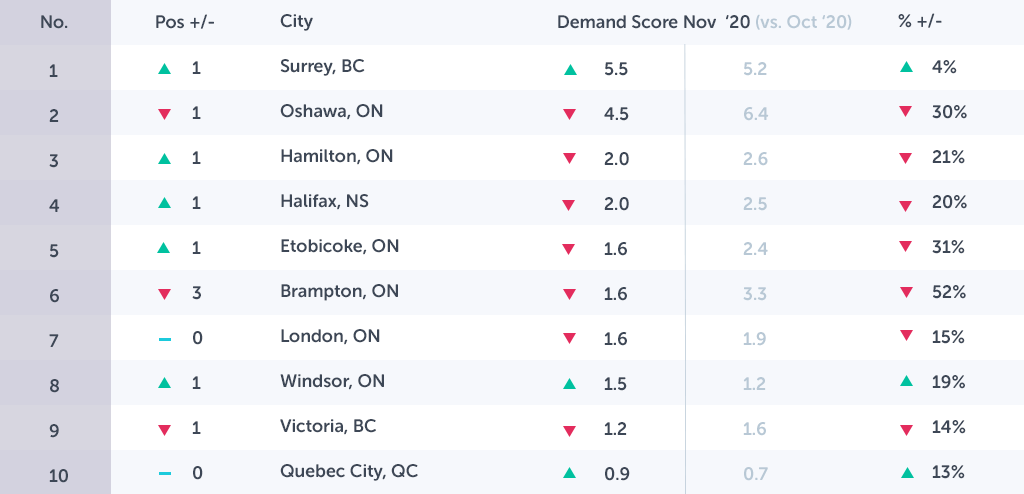
Notable Changes in Secondary Market Demand Over the Past Month
Upward
Surrey, ON increased demand by 0.3 points this month and has seen an increase of 4% in unique prospects per property this month versus last.
Windsor, ON saw an increase of 0.3 demand points and an increase of 19% unique prospects per property versus last month.
Quebec City, QC experienced an increase of 0.2 in demand and an increase of 13% unique prospects per property this month.
Downward
Oshawa, ON decreased by 1.2 demand points and saw a 17% decrease in unique prospects per property this month versus last month.
Hamilton, ON experienced a 1.5 decrease in demand and a 21% decrease in unique prospects per property this month versus last.
Halifax, NS saw a 0.5 point decrease in demand and a 20% decrease in unique prospects per property.
Etobicoke, ON went down by 0.8 in demand and experienced a 31% decline in unique prospects per property.
Brampton, ON experienced the greatest decline in secondary markets this month, and saw a 1.9 point decline in demand and a 52% decrease in unique prospects per property.
London, ON saw a slight decline in demand (0.3) and 15% decrease in unique prospects per property this month versus last month.
Victoria, BC dropped by 0.4 demand points this month, and saw a decrease of 14% unique prospects per property.
*Secondary markets experienced the greatest increase in supply this month (+8.2%) contributing to a -19.6% decrease in unique prospects per property on average this month versus last month.
*Overall, total unique prospects decreased by -13.2% on average for the month (See the year-over-year analysis below, for more perspective on demand in secondary markets.)
Canadian Cities – Secondary Market Drill Down (Y/Y): Nov 2020 vs. Nov 2019
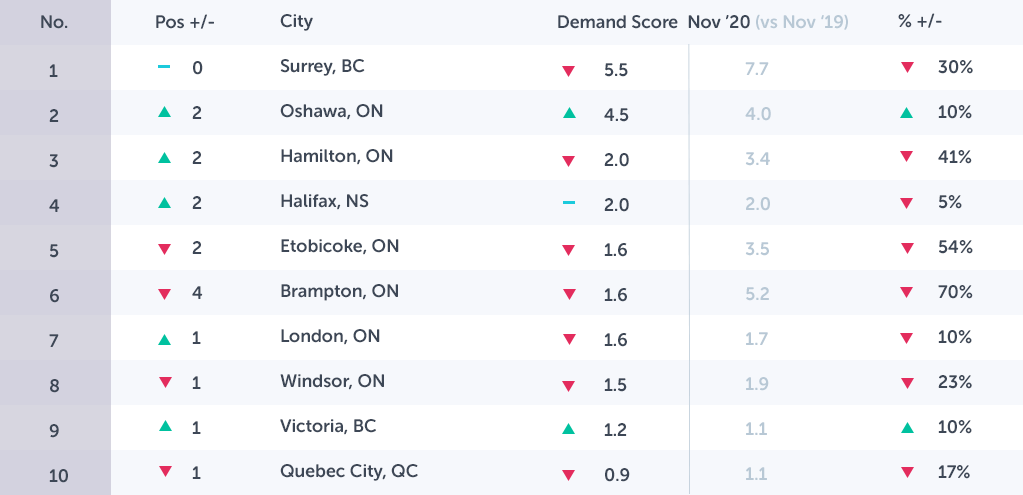
Notable Changes in Secondary Market Demand Over the Past Year
Upward
Oshawa, ON increased demand by 2.1 points and 16% unique prospects per property this year versus last year.
Victoria, BC had a 0.5 increase in demand this year, and a 10% increase in unique prospects per property versus this time last year.
Downward
Surrey, BC decreased in demand by 2.2 points and had a 30% decline in unique prospects per property this year versus this time last year.
Hamilton, ON decreased in demand by 1.4 points, and saw a decline in unique prospects per property by 41% this year versus last.
Etobicoke, ON demand decreased by 1.9 points and saw a 54% decline in unique prospects per property.
Brampton, ON decreased in demand by 3.6 points this year and experienced a 70% decline in unique prospects per property this year versus this time last year.
London, ON saw a slight decrease (0.1) in demand this year, and experienced a 10% decrease in unique prospects per property versus this time last year.
Quebec City, QC decreased by 0.2 demand points and saw a 17% decline in unique prospects per property.
*Overall, total unique prospects are up 1.7% in secondary markets this year, however, supply is up 29% in secondary markets, which is accounting for a -30.8% decrease on in unique prospects per property.
*Secondary markets that are close to densely populated areas with less space and higher rental rates, such as Brampton, ON, and Etobicoke, ON, are experiencing the greatest decline in secondary market demand. Remote work is making it possible for renters to look elsewhere for housing.
Tertiary Markets (Populations ~235-175K)
Canadian Cities – Tertiary Markets Drill Down (M/M): Nov 2020 vs. Oct 2020
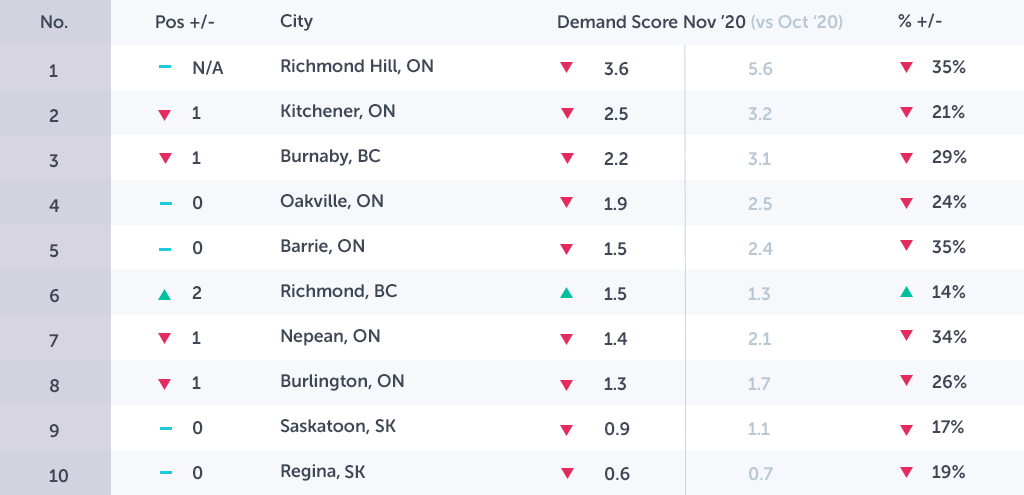
Notable Changes in Tertiary Market Demand Over the Past Month
Upward
Richmond, BC experienced a slight increase in demand (+0.3) and in unique prospects per property (14%) this month versus last month.
Downward
Kitchener, ON saw a 0.7 decrease in demand and a 21% decline in unique prospects per property this month versus last year.
Burnaby, BC decreased 0.9 demand points this month and -29% in unique prospects per property.
Oakville, ON saw a 0.6 decrease in demand and a 24% decline in unique prospects per property this month versus last month.
Barrie, ON went down 0.9 demand points and declined 35% in unique prospects per property.
Nepean, ON decreased demand by 0.8 points and saw a decline of 25% in unique prospects per property this month.
Burlington, ON declined by 1.3 demand points and decreased by 26% unique prospects per property.
Saskatoon, SK decreased demand by 0.9 points and -17% unique prospects per property this month versus last month.
Regina, SK decreased in demand by 0.6 points and -19% unique prospects per property this month.
*Tertiary markets saw a +2% increase in supply this month, and -26.6% on average decrease in unique prospects per property versus last month.
*Overall tertiary markets saw a -18.1% on average decrease in total unique prospects this month versus last month.
(See the year-over-year analysis below, for more perspective on demand in tertiary markets.)
Canadian Cities – Tertiary Markets Drill Down (Y/Y): Nov 2020 vs. Nov 2019
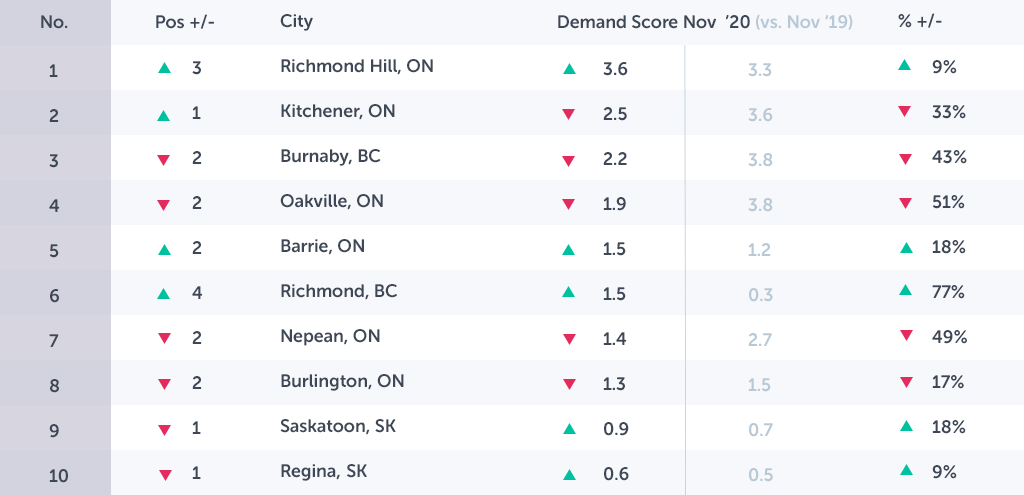
Notable Changes in Tertiary Demand Over the Past Year
Upward
Richmond Hill, ON experienced an increase in year-over-year demand (+0.3) and an increase of 9% unique prospects per property.
Barrie, ON saw a 0.3 point increase in demand as well as a 18% increase in unique prospects per property this year versus the same time last year.
Richmond, BC saw a drastic 1.2 point increase in demand this year, and a 77% increase in prospects per property versus last year.
Saskatoon, SK increased its demand by 0.2 points and unique prospects per property by 18% this year versus the same time last year
Regina, SK increased demand by 0.1 point and 9% unique prospects per property this year versus this time last year.
Downward
Kitchener, ON decreased demand by 1.1 points and unique prospects per property by 33% this year versus last year.
Burnaby, BC decreased demand by 1.6 points and -43% unique prospects per property from this time last year.
Oakville, ON saw a decrease in demand by 1.9 and a 51% decline in unique prospects per property this year versus this time last year.
Nepean, ON experienced a 1.3 point decline in demand, and a 49% decrease in unique prospects per property.
Burlington, ON saw a 0.2 point decrease in demand, and a 17% decrease in unique prospects per property this year versus this time last year.
*Overall, the number of properties are up 21.9% this year versus the same time last year in tertiary markets.
*There has been a 20.4% decrease in unique prospects per property in tertiary markets despite an increase of 19.1% in total unique prospects this year versus the same time last year. This can be attributed to stagnation due to spiking COVID cases, and less movement overall.
Conclusion
The data shown in this report shows that rental market demand has declined, but is showing resilience, despite seasonal shifts and the impact of COVID-19 shutdowns. A significant increase in supply across primary, secondary, and tertiary markets and a decrease in unique prospects, is creating a significant month-over-month decline in demand in these areas.
However, it is important to highlight the notable year-over-year changes in demand in certain markets. Primary markets are continuing to experience declining demand, where some secondary and tertiary markets are seeing a year-over-year increase in demand due to migration away from city centers. Areas with lower populations and more affordable housing are seeing the greatest increase in demand.
We will continue to monitor, and provide an in-depth data analysis, month-over-month, and year-over-year to provide you with the most accurate insights that can help to support your ongoing marketing and advertising strategies, especially as we navigate through these unprecedented times.
